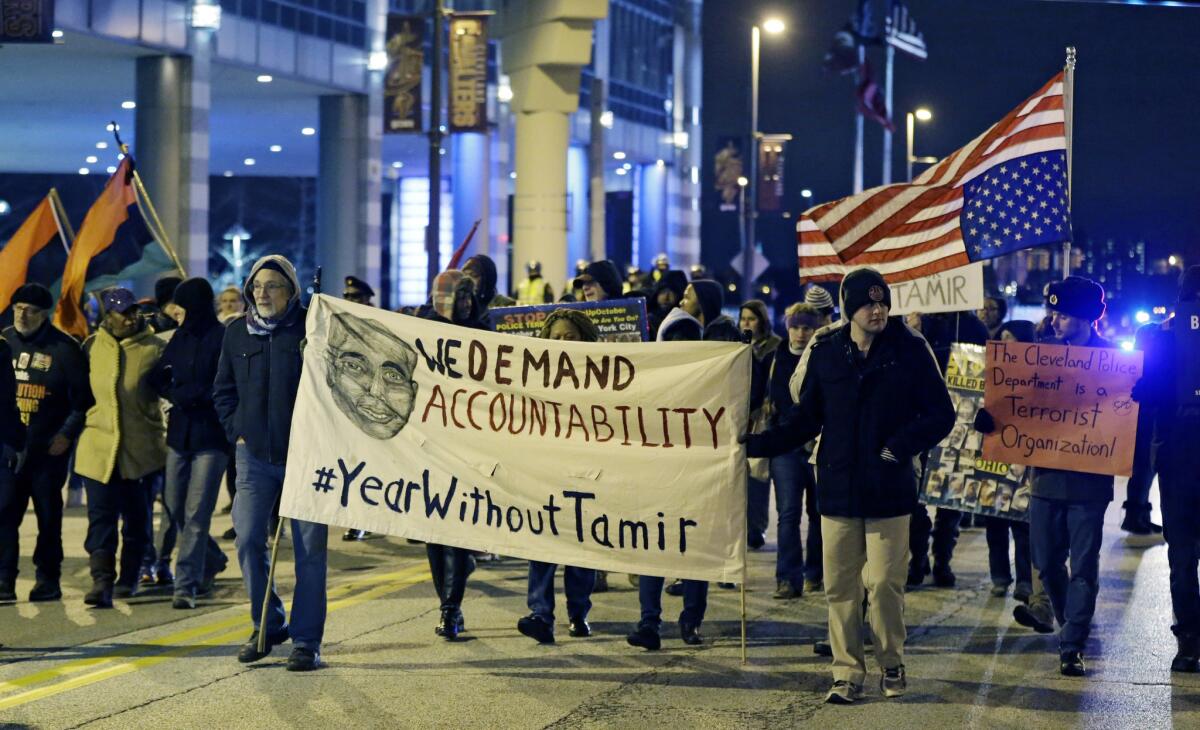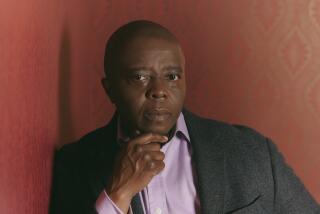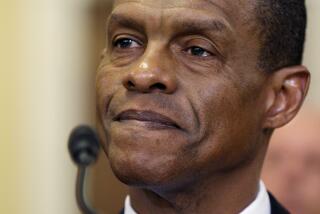Editorial: Shootings show tactics and judgment of U.S. police forces need to change

People protest a grand jury’s decision not to indict two white Cleveland police officers in the fatal shooting of Tamir Rice, a black 12-year-old boy who was playing with a pellet gun, in Cleveland on Dec. 29.
- Share via
A 12-year-old boy ought to be able to play in a park without being fatally shot by police. A concerned 911 caller seeing him wave a toy gun ought to be able to alert the authorities in Cleveland without virtually sentencing the child to death. A man in custody ought to be able to ride in the back of a Baltimore police van without mortal injury. A young man ought to be able to drive his date to a fast-food restaurant in a small South Carolina town without being slain by an officer looking for illegal drugs.
These and hundreds of other Americans who died at the hands of police in the last year and a half ought to have been able to play, run, date, even get into some minor trouble, and still live to tell about it.
Fundamental problems in U.S. policing extend beyond the racial and economic patterns that make African Americans more likely to be crime victims ... [and] to be killed by police.
Instead, their deaths are an indictment of policing practices that are woefully outdated and insufficiently examined. And of course they are a reflection of a society and a justice system inextricably bound up with race.
There were more white than black victims of police killings in 2015, but African Americans were killed far more often in proportion to their numbers in the general population — according to statistics compiled by the Washington Post and the Guardian. The U.S. government does not gather official nationwide statistics of police killings (see accompanying editorial).
Tamir Rice, for example, the young African American boy with the toy gun, was shot by a white Cleveland police officer in November 2014. White cop, black victim — echoing the killing a month earlier of 17-year-old Laquan McDonald, shown in a video (withheld from the public until late this year) being shot 16 times while walking away from a Chicago police officer; the killing of Michael Brown in Ferguson, Mo., that same year; and the killing of Eric Garner on Staten Island, also in 2014. The protests of the Black Lives Matter movement have forced the nation to reckon with police killings of black men, who were often unarmed.
It’s about time; clearly racialized policing is a real problem and one that law enforcement agencies have failed to address for far too long. But it is important to remember that not all police killings fit so simple a mold and not all of them comport so easily with the assertion that the nation’s policing problems are rooted solely in white police bigotry toward blacks. Half the officers charged in the death of Freddie Gray, the black man who died in the Baltimore police van last April following a dubious arrest on a weapons charge, are also African American. Zachary Hammond, the 19-year-old Seneca, S.C., man on a date at Hardee’s in July when shot by a white officer, was white (no charges were brought against the officer). And Los Angeles, which leads the nation in police shootings, has a racially diverse police force that reflects the city’s multiethnic population.
Fundamental problems in U.S. policing extend beyond the racial and economic patterns that make African Americans more likely to be crime victims, more likely to be arrested and more likely to be killed by police. They implicate basic nuts-and-bolts issues, such as tactics and judgment.
That fact was tacitly acknowledged Wednesday by Chicago Mayor Rahm Emanuel, who promised to roll out new training in less-confrontational policing and alternatives to lethal force in the wake of the video of the McDonald shooting and continuing police violence that appears tragically unnecessary, such as the recent shooting deaths of Quintonio LeGrier and Bettie Jones.
Emanuel’s statements, while welcome, are embarrassingly tardy and shockingly inadequate. Police in large American cities ought to be setting worldwide standards for de-escalation, less-than-lethal force and cautious encounters with subjects instead of using military-style, shoot-first tactics. Emanuel should be able to draw on knowledge and best practices compiled by dozens of cities and not put so much stock in Tasers, which also can be lethal. It should be a given that people such as LeGrier’s father or the person who saw Tamir with the toy should be able to call 911 and be answered by professionals well-versed in practices geared toward the safety of suspects as well as themselves and bystanders. But Los Angeles and other cities have only recently begun embracing specialized training to help officers, for example, recognize and deal with mentally ill people and employ other, more modern response protocols.
When police encounters fail — when they result in death — the questions asked in official inquiries are too often limited to whether the officers’ actions were “objectively reasonable.”
That may be the appropriate question when determining whether the officer should stand trial for murder. But decisions not to indict officers (as in the cases of the officers who killed Tamir and Hammond) or not to convict them (as in the hung jury in the first prosecution in Gray’s death) must not be taken as statements that nothing went wrong. The appropriate question for police discipline bodies, chiefs, trainers and elected officials ought to be whether officers had, were aware of and could have used alternatives that were likely to result in better outcomes.
It is a lot to ask of officers — to be prepared at a moment’s notice to confront mass killers, as in San Bernardino, and be at the same time ready to keep their heads when responding to a report of a boy holding a gun that may or may not be real. But it is a standard of performance that is met by police elsewhere — in Britain, for example — and should be the standard in U.S. cities as well.
Follow the Opinion section on Twitter @latimesopinion and Facebook
More to Read
A cure for the common opinion
Get thought-provoking perspectives with our weekly newsletter.
You may occasionally receive promotional content from the Los Angeles Times.










